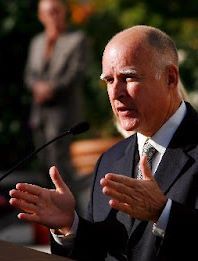Assessing Gov. Brown before next year’s election
by Katy Grimes | August 2, 2013 2:20 pm
As he lays the groundwork for a likely re-election bid next year, Gov. Jerry Brown is upbeat. “California is back,” he and his supporters insist.
 Maybe it is in some areas. But overall, tremendous problems remain unresolved.
Maybe it is in some areas. But overall, tremendous problems remain unresolved.
According to a recent USA Today news story[1], 10 cities in California are on the brink of bankruptcy: Atwater, Azusa, Compton, Fresno, Hercules, Mammoth Lakes, Monrovia, Oakland, San Jose and Vernon.
Atwater declared a fiscal emergency last October. All 10 have had their credit ratings significantly downgraded. Mammoth Lakes already filed for federal bankruptcy protection, but withdrew its petition.
San Jose has run 11 consecutive general fund deficits. Oakland is cutting police and other city services. And Fresno nearly privatized its citywide garbage pickup. Sacramento can’t be far behind, with delusions of grandeur for a publicly funded arena on the horizon. The state Capitol needs a new sewer system, not a new NBA palace for the Sacramento Kings.
And of course, last year two cities actually did declare bankruptcy: Stockton and San Bernardino. They didn’t get as much publicity as the recent Detroit bankruptcy. But the two cities’ populations combined equal 500,000, not far behind Detroit’s 700,000.
Brown’s third term
One year into his third term as governor, during his 2012 State of the State address, Brown touted[2] California’s “recovering” economy. He also led a cheer as he pushed for his tax increase measure, Proposition 30[3]. And it worked.
Prop. 30 was passed by voters in November 2012. It raised the sales tax on everyone, and upped the income tax on individuals and small businesses making more than $250,000 a year.
“California is on the mend,” Brown said in 2012 as he spent the year touting the High-Speed Rail plan, pushed for implementation of AB 32[4], implemented the go-it-alone cap-and-trade plan, advanced an expensive Delta water project, and set a goal of achieving 20,000 megawatts of renewable energy by 2020 even though[5] California cannot provide enough consistent electricity to the state using traditional methods.
While he touted California’s economic recovery, Brown criticized “dystopian journalists” and Republican critics. It’s likely to be a major campaign theme next year. And as he showed in his 2010 bid, he still knows how run an effective campaign.
Deja vu all over again
Brown is notorious for saying the state “lives within its means.” And the budget this year balances on paper. However, High-Speed Rail would cost $68 billion and the Delta water tunnel plan would cost $25 billion. He also admits he has yet to deal with what he calls a “wall of debt[6]“: largely money owed for pensions; and for unemployment insurance payments borrowed from the federal government.
Led by Brown, California politicians continue to espouse the belief that our fabulous climate, beautiful beaches, world-class ski resorts and hip California lifestyle will always keep the rich here paying taxes.
State politicians claim that the state’s wine industry, agriculture, computer geniuses in Silicon Valley, the University of California system and even Hollywood will always be enough to keep the state from ending up like Detroit.
But the seeming prosperity is like a castle built on the sand of one of the state’s famous beaches. Compared to Texas, Florida and other states with more business-friendly environments, California is not well placed to confront the next recession, whenever it occurs. The next slump could end up being a lot like the devastation of 2008-10, with the current prosperity washed out to sea.
- recent USA Today news story: http://www.usatoday.com/story/news/nation/2013/05/15/ten-california-cities-in-distress/2076217/
- 2012 State of the State address, Brown touted: http://gov.ca.gov/news.php?id=17386
- Proposition 30: http://ballotpedia.org/wiki/index.php/California_Proposition_30,_Sales_and_Income_Tax_Increase_(2012)
- AB 32: http://ballotpedia.org/wiki/index.php/California's_AB_32,_the_%22Global_Warming_Solutions_Act_of_2006%22
- achieving 20,000 megawatts of renewable energy by 2020 even though: http://governors.library.ca.gov/addresses/39-Jbrown03.html
- wall of debt: http://www.news10.net/news/article/251007/2/Brown-tackles-debt-wall-but-other-walls-loom-large
Source URL: https://calwatchdog.com/2013/08/02/assessing-gov-brown-before-next-years-election/